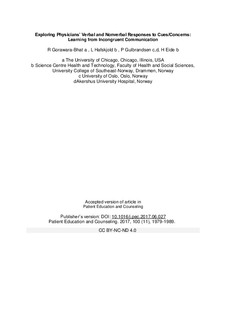Exploring physicians' verbal and nonverbal responses to cues/concerns: Learning from incongruent communication
Journal article, Peer reviewed
Accepted version
Permanent lenke
http://hdl.handle.net/11250/2493286Utgivelsesdato
2017Metadata
Vis full innførselSamlinger
Originalversjon
Patient Education and Counseling. 2017, 100 (11), 1979-1989. 10.1016/j.pec.2017.06.027Sammendrag
Objectives Explore physicians’ verbal and nonverbal responses to cues/concerns in consultations with older-patients. Methods Two teams independently coded a sample of Norwegian consultations (n = 24) on verbal and nonverbal dimensions of communication using VR-CoDES and NDEPT instruments. Consultations exploring older-patients’ verbal emotional expressions were labeled ‘Acknowledging of patients’ emotional expressions’, and ‘Distancing from patients’ emotional expressions.’ Based on type and extent of nonverbal expressiveness, consultations were labeled ‘Affective’ and ‘Prescriptive.’ Congruency of verbal and nonverbal communication was assessed and categorized into four types. Incongruent consultations were qualitatively analyzed. Results Types 1 and 2 consultations were described as ‘Congruent,’ i.e. both verbal and nonverbal behaviors facilitate or inhibit emotional expressions. Types 3 and 4 were considered ‘Incongruent,’ i.e. verbal inhibits, but nonverbal facilitates emotional expressions or vice versa. Type 3 incongruent encounters occurred most often when it was challenging to meet patients’ needs. Conclusions Frequently physicians’ display incongruent behavior in challenging situations. Older patients’ may perceive this as either alleviating or increasing distress, depending on their needs. Practice implications Type 3 consultations may shed light on reasons for physicians’ incongruent behavior; therefore, independent measurement and analyses of verbal and nonverbal communication are recommended. Older-patients’ perceptions of incongruent communication should be further explored.

